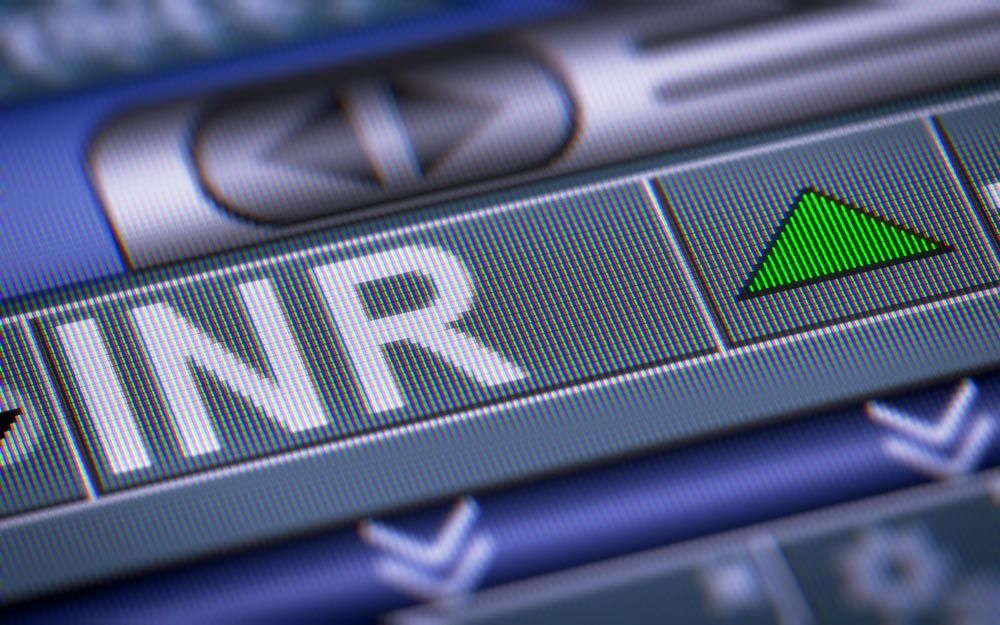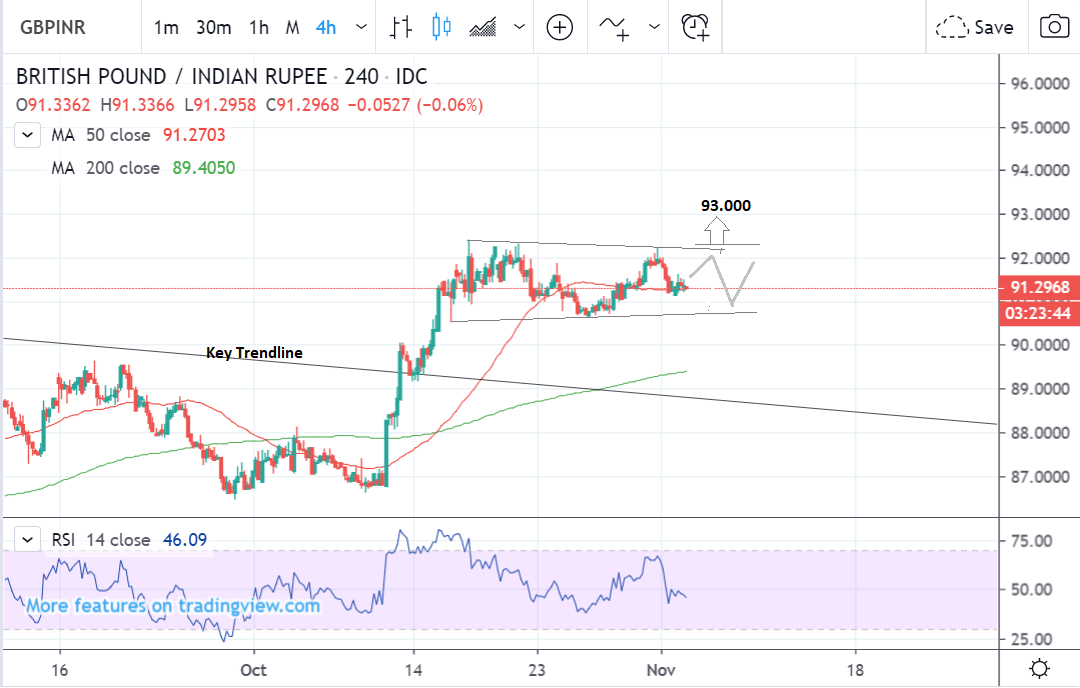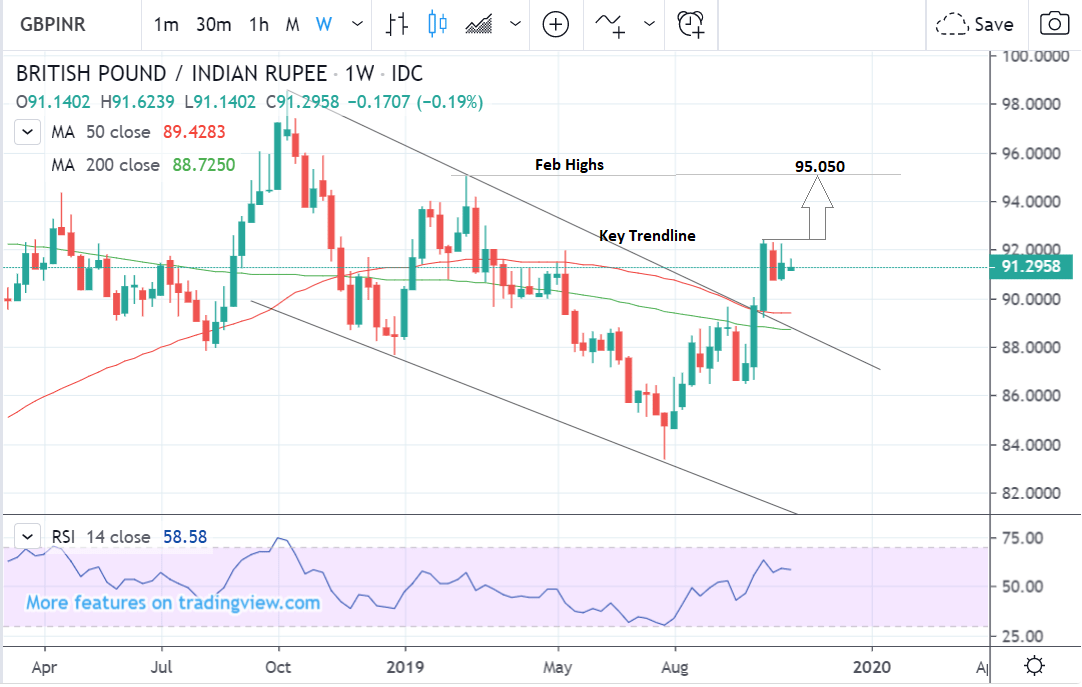Pound-Rupee Rate Forming Bullish Continuation Pattern, Advocates for Further Gains

Image © Adobe Images
- GBP/INR is forming a bull flag pattern
- Break above the highs could lead to strong rally
- Rupee to be moved by global risk appetite and USD
The Pound-to-Rupee exchange rate GBP/INR is trading at around 91.30 at the time of writing having risen 0.73% in the week before. Concerning the outlook, charts show the pair pulling back in a correction although the overall bullish trend is expected to resume eventually.
The 4hr chart - used to determine the short-term outlook, which includes the coming week - shows the pair is now trading in a sideways range between roughly the mid-90 and mid-92 Rupee levels.
He sideways trend probably just represents a pause in the already established uptrend and once over it will probably result in a continuation higher.
A break above the 92.40 high would provide confirmation of a continuation higher to a target at 93.00.
The weak RSI momentum gauage, however, suggests there is also a risk that the sideways trend could simply continue unfolding without a break higher during the forecast period.
The daily chart is showing the formation of a bullish pattern which indicates the possibility of higher prices should it break higher.
The pattern may be a bull flag, which is composed of sideways consolidation (the ‘flag’) and a steep rally preceding it called the ‘pole’.
A break above the 92.40 highs would provide the necessary confirmation for a continuation up to a target at 94.25, which is the 61.8% extrapolation of the ‘pole’, the usual method for establishing a conservative target for the bull flag.
The daily chart is used to give us an indication of the outlook for the medium-term, defined as the next week to a month ahead.
The weekly chart shows how the pair has broken above a key trendline reversing the long-term downtrend and initiating a more bullish outlook for the pair.
Subject to a break above the October 17 highs and further gains, the pair could go as high as 95.05 in the long-term, the maximum target for the bull flag, based on a 100% extrapolation of the flag pole.
The weekly chart is used to give us an indication of the outlook for the long-term, defined as the next few months.
Time to move your money? Get 3-5% more currency than your bank would offer by using the services of a specialist foreign exchange specialist. A payments provider can deliver you an exchange rate closer to the real market rate than your bank would, thereby saving you substantial quantities of currency. Find out more here. * Advertisement
The Rupee: What to Watch
The main driver of the Rupee is likely to be global investor risk appetite and the fluctuations of the U.S. Dollar to which it is negatively correlated.
At the time of writing U.S. stock indices such as the Dow Jones and the S&P 500 are trading higher on a more optimistic outlook for world trade and global growth.
The increased investor appetite for risk is also likely to support emerging market (EM) currencies such as the Indian Rupee which are sensitive to risk trends.
The main reason for the brighter outlook is that the U.S.-China Phase 1 trade deal looks to be in the final stages of completion with the two parties now expected to sign the text of the deal in mid-November.
The deal will lead to de-escalation in the trade war which has negatively impacted on world trade.
Concrete progress has already been made in addressing the trade bans each country has imposed on the other.
U.S. Commerce Secretary Wilbur Ross said, on Sunday, that licenses for American companies to export certain technology products to previously banned Chinese tech giant Huawei “will be forthcoming very shortly”, which marks a considerable breakthrough.
Risk appetite also gained an uplift after the release of better-than-expected manufacturing data for small and medium-sized companies in China, which showed a strong rebound in October.
“The Caixin China manufacturing PMI was also stronger than expected, reaching its highest level since the start of 2017, in a sign that Chinese growth may have bottomed,” says Nick Smyth of BNZ bank.
One risk to the current positive backdrop to risk markets is that the U.S - China trade deal remains limited and does not lead to a bigger more comprehensive deal down the line as was previously promised by Donald Trump.
Chinese officials are sceptical about a more comprehensive deal. For that to happen the U.S would have to agree to the removal of all punitive tariffs on China, essentially undoing all the measures implemented under President’s Trump ‘America First’ campaign - a demand which is highly unlikely to be met under this administration.
Another key driver of the Rupee is the U.S. Dollar to which it is negatively correlated.
The main driver of the U.S. Dollar this week is the ISM non-manufacturing PMI survey out on Tuesday.
The ISM will provide an insight into the performance of a part of the economy which has remained relatively insulated from the global slowdown in heavy industry.
Analysts will be watching it for signs of contagion, which might signal an impending recession, so substantial weakness in the data is likely to impact negatively on the Dollar - positively on the Rupee.
The ISM non-manufacturing PMI is out on Tuesday at 15.00 GMT. Current market expectations are for a rise to 53.4 from 52.6. The employment sub-index is also likely to garner a lot of attention due to woeful underperformance in recent months.
In summary, a higher-than-expected reading in either the main or employment sub-index should be taken as positive or bullish for the U.S. Dollar (negative or bearish for the Rupee), while a lower than expected reading should be taken as negative or bearish for the Dollar (bullish for the Rupee).
Time to move your money? Get 3-5% more currency than your bank would offer by using the services of a specialist foreign exchange specialist. A payments provider can deliver you an exchange rate closer to the real market rate than your bank would, thereby saving you substantial quantities of currency. Find out more here. * Advertisement


